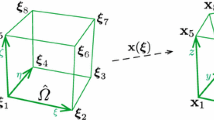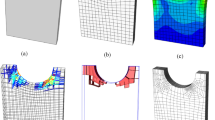Abstract
Hexahedral mesh is of great value in the analysis of mechanical structure, and the mesh quality has an important impact on the efficiency and accuracy of the analysis. This paper presents a quality improvement method for hexahedral meshes, which consists of node classification, geometric constraints based single hexahedron regularization and local hexahedral mesh stitching. The nodes are divided into different types and the corresponding geometric constraints are established in single hexahedron regularization to keep the geometric shapes of original mesh. In contrast to the global optimization strategies, we perform the hexahedral mesh stitching operation within a few local regions surrounding elements with undesired quality, which can effectively improve the quality of the mesh with less consuming time. Several mesh quality improvements for hexahedral meshes generated by a variety of methods are introduced to demonstrate the effectiveness of our method.










Similar content being viewed by others
References
Khuyagbaatar, B., Kim, K., & Kim, Y. H. (2023). Recent developments in finite element analysis of the lumbar spine. International Journal of Precision Engineering and Manufacturing. https://doi.org/10.1007/s12541-023-00866-9
Zhang, Y., Xu, H., Peng, R., et al. (2022). The state of the art of finite element analysis in mechanical clinching. International Journal of Precision Engineering and Manufacturing-Green Technology., 9(4), 1191–1214.
Blacker, T. (2000). Meeting the challenge for automated conformal hexahedral meshing. In 9th International meshing roundtable (pp. 11–20).
Sun, L., Zhao, G. Q., & Ma, X. W. (2012). Quality improvement methods for hexahedral element meshes adaptively generated using grid-based algorithm. International Journal for Numerical Methods in Engineering, 89(6), 726–761.
Ledoux, F., & Shepherd, J. (2010). Topological modifications of hexahedral meshes via sheet operations: A theoretical study. Engineering with Computers, 26(4), 433–447.
Nielsen, C. V., Fernandes, J. L. M., et al. (2013). All-hexahedral meshing and remeshing for multi-object manufacturing applications. Computer-Aided Design, 45(5), 911–922.
Wang, R., Gao, S., Zheng, Z., & Chen, J. (2018). Hex mesh topological improvement based on frame field and sheet adjustment. Computer Aided Design, 103, 103–117.
Field, D. A. (1998). Laplacian smoothing and Delaunay triangulations. Communications in Applied Numerical Methods, 4(6), 709–712.
Freitag, L. A. (1997). On combining Laplacian and optimization-based mesh smoothing techniques. In Trends in unstructured mesh generation (pp. 37–43).
Leng, J., Xu, G., Zhang, Y., Qian, J. (2013). Quality improvement of segmented hexahedral meshes using geometric flows. In Image-based geometric modeling and mesh generation (pp. 195–221). Springer.
Vartziotis, D., Wipper, J., & Papadrakakis, M. (2013). Improving mesh quality and finite element solution accuracy by GETMe smoothing in solving the Poisson equation. Finite Elements in Analysis and Design, 66, 36–52.
Vartziotis, D., & Wipper, J. (2011). A dual element based geometric element transformation method for all-hexahedral mesh smoothing. Computer Method in Applied Mechanics and Engineering, 200(9–12), 1186–1203.
Knupp, P. M. (2000). Achieving finite element mesh quality via optimization of the Jacobian matrix norm and associated quantities. Part II—A framework for volume mesh optimization and the condition number of the Jacobian matrix. International Journal for Numerical Methods in Engineering, 48(3), 1165–1185.
Yilmaz, A. E., & Kuzuoglu, M. (2009). A particle swarm optimization approach for hexahedral mesh smoothing. International Journal for Numerical Methods in Fluids, 60(1), 55–78.
Ruiz-Gironés, E., Roca, X., & Sarrate, J. (2014). Optimizing mesh distortion by hierarchical iteration relocation of the nodes on the CAD entities. Procedia Engineering, 82, 101–113.
Ruiz-Gironés, E., Roca, X., Sarrate, J., Montenegro, R., & Escobar, J. M. (2015). Simultaneous untangling and smoothing of quadrilateral and hexahedral meshes using an object-oriented framework. Advance Engineering Software, 80, 12–24.
Livesu, M., Sheffer, A., Vining, N., et al. (2015). Practical hex-mesh optimization via edge-cone rectification. ACM Transactions on Graphics, 34(4), 141:1-141:11.
Xu, K., Gao, X., & Chen, G. (2017). Hexahedral mesh quality improvement via edge-angle optimization. Computers & Graphics, 70, 17–27.
Vartziotis, D., & Bohnet, D. (2017). A geometric mesh smoothing algorithm related to damped oscillations. Computer Methods in Applied Mechanics and Engineering, 326, 102–121.
Peng, W., Lu, D., Huang, T., et al. (2015). Hexahedral mesh smoothing via local element regularization and global mesh optimization. Computer-Aided Design, 59, 85–97.
Page, D. L., Sun, Y., Koschan, A. F., et al. (2002). Normal vector voting: Crease detection and curvature estimation on large, noisy meshes. Graphical Models, 64, 199–229.
Kim, H. S., Han, K. C., & Lee, K. H. (2009). Feature detection of triangular meshes based on tensor voting theory. Computer Aided Design, 41, 47–58.
Besl, P. J., & Mckay, N. D. (1992). A method for registration of 3-D shapes. IEEE Transactions on Pattern Analysis and Machine Intelligence, 14(2), 239–256.
Knupp, P. M. (2003). A method for hexahedral mesh shape optimization. International Journal for Numerical Methods in Engineering, 58(2), 319–332.
Dhatt, G., Lefrançois, E., & Touzot, G. (2012). Finite element method (1st ed.). Wiley.
Peng, W., Lu, D., Huang, T., et al. (2013). As-rigid-as-possible mesh deformation and its application in hexahedral mesh generation. Advances in Engineering Software, 65, 158–167.
Lu, H. C., Quadros, W. R., & Shimada, K. (2017). Evaluation of user-guided semi-automatic decomposition tool for hexahedral mesh generation. Journal of Computational Design and Engineering, 4, 330–338.
Huang, L., Zhao, G., Wang, Z., et al. (2016). Adaptive hexahedral mesh generation and regeneration using an improved grid-based method. Advances in Engineering Software, 102, 49–70.
Maréchal, L. (2009). Advances in octree-based all-hexahedral mesh generation: Handling sharp features. In Proceedings of the 18th international meshing roundtable (pp. 65–84).
Acknowledgements
This work was funded by the Project of the National Natural Science Foundation of China (No.11402264) and Open Fund of Jiangsu Key Laboratory of Precision and Micro Manufacturing Technology. These supports are gratefully acknowledged.
Author information
Authors and Affiliations
Corresponding author
Additional information
Publisher's Note
Springer Nature remains neutral with regard to jurisdictional claims in published maps and institutional affiliations.
Rights and permissions
Springer Nature or its licensor (e.g. a society or other partner) holds exclusive rights to this article under a publishing agreement with the author(s) or other rightsholder(s); author self-archiving of the accepted manuscript version of this article is solely governed by the terms of such publishing agreement and applicable law.
About this article
Cite this article
Peng, W., Mei, X., Shao, K. et al. Hexahedral Mesh Quality Improvement with Geometric Constraints. Int. J. Precis. Eng. Manuf. 24, 2337–2348 (2023). https://doi.org/10.1007/s12541-023-00898-1
Received:
Revised:
Accepted:
Published:
Issue Date:
DOI: https://doi.org/10.1007/s12541-023-00898-1




